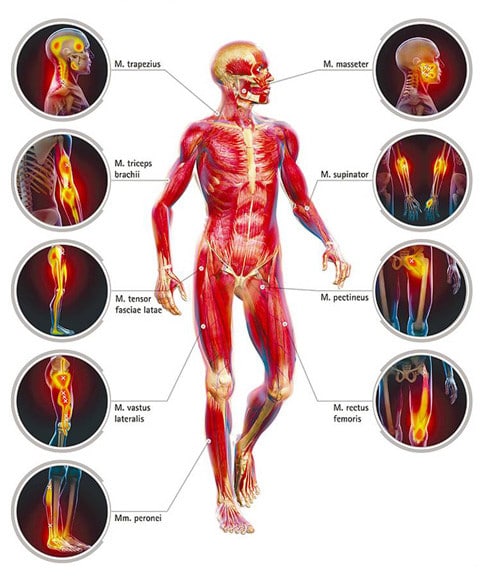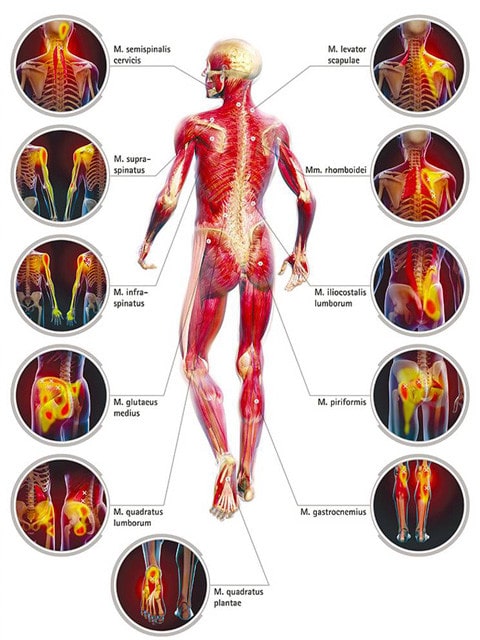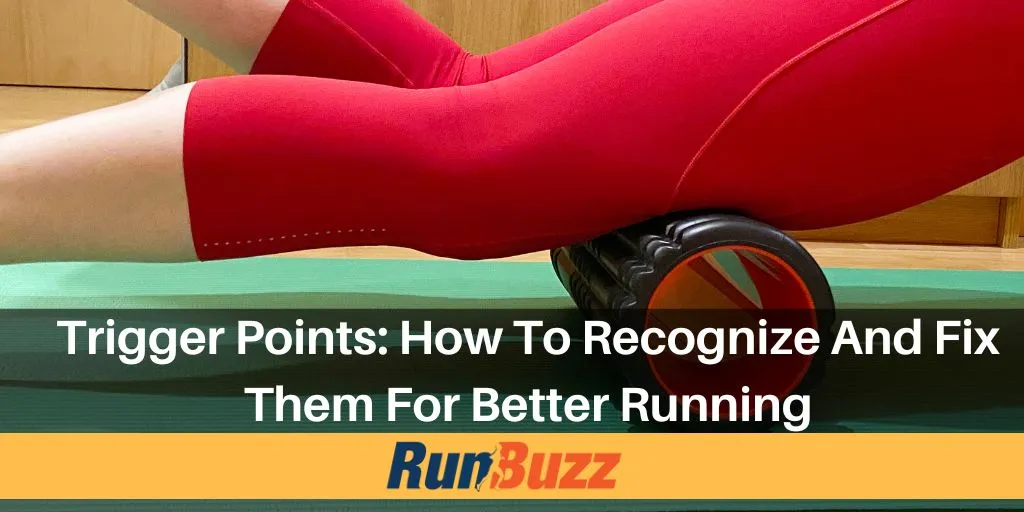Trigger points are hypersensitive knots in muscle fibers, commonly resulting from repetitive strain, injury, or stress. These knots can cause significant pain, even under light pressure, and may radiate discomfort to other body areas. They typically form due to repetitive activities, such as running, or from maintaining poor posture.
If you have pain in your calf, quad, piriformis, shoulders, neck back, any place really, trigger points could be a source, especially in highly repetitive muscle areas.
As trigger points develop, they can also cause pain in areas away from the trigger point. This condition is known as referred pain. Referred pain is caused due to sensory cells being overwhelmed thus propagating pain signals up the chain.
In this guide, I will share what trigger points are, how they are caused, common trigger point areas that affect runners, and some ways to reduce, or eliminate them.
What are Trigger Points?
As runners, if we know what causes trigger points and know what they feel like, it will help reenforce the importance of mobility exercises, muscle massage, and other self-myofacial release techniques. And if we routinely take care of ourselves, we will feel amazing for it!
How are they created?
While we know repetitive stress plays a role, let’s dive deeper into their formation within the muscle fibers themselves.
Imagine your muscle as a microscopic factory:
- Inside, tiny machines called sarcomeres work like assembly lines, using protein chains to contract and relax, making your muscle move.
- Each sarcomere has a precise structure and rhythm, like well-oiled gears.
Now, picture a malfunction:
- Repetitive stress or injury can disrupt this smooth operation. Some sarcomeres might get stuck in a contracted state, forming a knot – the trigger point.
- This disrupts the whole assembly line, leading to:
- Reduced blood flow: Like clogged pipes, fewer nutrients and oxygen reach the area.
- Waste buildup: Without proper flow, waste products accumulate, like fumes from idling machines.
- Hypersensitivity: The stressed-out sarcomeres become overly sensitive to touch, sending pain signals like frantic alarms.
Now think of it like a domino effect:
- Over time, our muscles develop scar tissue or heal around them. As one sarcomere gets stuck, it affects its neighbors.
- Clogged flow and waste buildup worsen the situation and more scar tissue or adhesion/inflammation develops.
- This build up triggers nerves and these overly sensitive spots scream “pain!” to your brain.
The key takeaway:
Trigger points are microscopic disruptions in the intricate machinery of your muscle fibers, causing a cascade of problems that lead to pain and tightness.
Remember:
- This is a simplified picture, and the exact mechanisms are still being explored.
- But hopefully, this provides a clearer understanding of the microscopic events behind those troublesome knots.
What does trigger point pain feel like?
Describing trigger point pain can be tricky because it can vary depending on the person and the location of the trigger point. However, here are some common characteristics:
Intensity:
- Dull aching: This is the most common type of trigger point pain, often described as a deep, throbbing ache in the muscle.
- Sharp, stabbing pain: Some trigger points can cause sudden, sharp bursts of pain, almost like a knife being twisted.
- Burning or tingling: This sensation is less common but can occur with certain trigger points, especially those affecting nerves.
Location:
- Localized: Trigger point pain is usually focused on a specific point within the muscle, often feeling like a small, tender bump.
- Referred pain: This is a hallmark of trigger points, where the pain radiates to other areas. For example, a trigger point in the shoulder might cause pain down the arm or into the neck.
Other characteristics:
- Tenderness: Applying pressure to the trigger point will typically cause pain or a flinching response.
- Tightness: The muscle where the trigger point is located may feel stiff and restricted in its movement.
- Weakness: Trigger points can weaken the affected muscle, making it harder to perform certain activities.
Remember: Not everyone experiences trigger point pain in the same way. If you’re unsure whether your pain is related to a trigger point, it’s always best to consult a healthcare professional for a proper diagnosis.
The below diagrams show common trigger point locations on the front and back of the body.
Common trigger point locations
Trigger Points (Front)

Trigger Points (Back)

Hamstring trigger points
The posterior tibialis is a long, deep muscle located on the back (posterior) side of the lower leg. It runs from the inner bone of the upper leg (tibia) down to the inner side of the foot. You can feel it as a bulge running down the back of your leg between your calf muscle and shin bone.oints
Hamstring trigger points are common with runners. Hamstring muscles play a vital role in running and walking.
Our hamstrings include three muscles: the biceps femoris, semitendinosus, and semimembranosus. These muscles work together to move your leg forward when you run and help you stand up straight. They are involved in flexing your leg at the knee when we run as well as extend the thigh at our hips and to a lesser degree rotating the thigh and lower leg.
These muscles often get overworked when we run, which is why taking care of them is key. Foam rolling and percussion massagers are the best way to get rid of hamstring trigger points. More details on how to get rid of them are found below.
Trigger points in our hamstrings typically occur in clusters found in the middle (or medial side) and / or to the outside of the hamstring (lateral). Pain with hamstring trigger points are often found at the rear of the thigh or knees, as well as in the lower back.
Piriformis trigger points
Piriformis trigger points are knots of tight muscle fibers within the piriformis muscle, a small but mighty hip rotator located deep in the buttock. These tender knots form due to various reasons, like overuse, injury, or poor posture, and can become a source of significant pain.
Common Causes:
- Repetitive strain: Activities like running, cycling, or climbing stairs can overuse the piriformis, leading to trigger point formation.
- Tightness and weakness: Muscles surrounding the piriformis, like the glutes and hamstrings, can become imbalanced, causing the piriformis to compensate and tighten up.
- Trauma: Direct injury to the hip, like a fall or sports impact, can trigger muscle fiber contraction and knot formation.
- Postural issues: Sitting for long periods with poor posture can shorten and tighten the piriformis, increasing trigger point risk.
Impact on Runners:
Runners are particularly susceptible to piriformis trigger points due to the repetitive hip flexion and rotation involved in running. These points can:
- Cause buttock pain: A deep ache or sharp pain in the gluteal region, sometimes radiating down the back of the thigh.
- Mimic sciatica: Pain can travel down the leg along the sciatic nerve, making it difficult to distinguish from true sciatica.
- Reduce running performance: Pain and limited hip mobility can affect stride length, speed, and endurance.
- Increase injury risk: Tightness and weakness in the piriformis can affect hip and knee mechanics, potentially leading to injuries like overuse syndromes.
Posterior Tibialis trigger points
The posterior tibialis is a long, deep muscle located on the back (posterior) side of the lower leg. It runs from the inner bone of the upper leg (tibia) down to the inner side of the foot. You can feel it as a bulge running down the back of your leg between your calf muscle and shin bone.
The posterior tibialis plays a crucial role in foot stability, arch support, and ankle movement.
Causes of Posterior Tibialis Trigger Points:
- Overuse and Repetitive Strain: Running, especially on uneven terrain or with poor form, can put constant stress on the posterior tibialis, leading to micro-tears and trigger point formation.
- Imbalances and Weakness: Weak calf muscles or other imbalances can put extra strain on the posterior tibialis, making it susceptible to trigger points.
- Improper Footwear: Worn-out or ill-fitting shoes can put undue pressure on the foot, contributing to muscle strain and trigger points.
- Flat Feet or Pronation: These conditions can affect how your foot distributes weight, potentially leading to strain and trigger points in the posterior tibialis.
- Injuries and Trauma: Sprains, fractures, or even overuse injuries like shin splints can damage the posterior tibialis, creating trigger points as the area heals.
Impact on Runners:
For runners, posterior tibialis trigger points can be more than just a nuisance:
- Pain and Discomfort: Trigger points can radiate pain in various areas of the foot and ankle, making running painful and limiting your range of motion.
- Reduced Stability and Balance: Tight or weak posterior tibialis can affect your foot’s stability and balance, increasing the risk of falls and other injuries.
- Decreased Performance: Pain and instability can impact your stride efficiency and power, hindering your pace and endurance.
Peroneal trigger points
Peroneal trigger points are taut bands or knots that develop in the peroneus muscles, located on the outside of your lower leg. These trigger points can be a source of significant pain and discomfort, often impacting your ankle and foot. Here’s what you need to know:
Causes:
- Overuse: Repetitive strain on the peroneus muscles from activities like running, jumping, or standing for long periods.
- Improper biomechanics: Poor foot arch support, flat feet, or leg length discrepancies can put undue stress on the peroneus muscles.
- Trauma: Injuries like ankle sprains or stress fractures can trigger muscle knots.
- Other factors: Tightness in other parts of the leg, dehydration, and nutritional deficiencies can contribute to trigger point formation.
Impact on Runners:
- Pain: Runners may experience localized pain on the outside of the ankle, radiating up the fibula bone or towards the outside of the foot.
- Weakness and instability: Trigger points can weaken the ankle, making it prone to rolling inward (pronation) and increasing the risk of sprains.
- Reduced performance: Pain and weakness can limit your running stride and overall performance.
Knee trigger points
Knee trigger points can form around the muscles around the knee and the top reasons thought to contribute to them are imbalances in the pelvis as well as overpronation in the foot. The knee will compensate for the imbalances and the repetitive nature of running can trigger points, or eventually can lead to more serious ailments such as patellar tendonitis, aka runner’s knee.
Common Causes of trigger points in the knee:
- Overuse and Repetitive Strain: Running, jumping, and other repetitive knee movements put constant stress on the surrounding muscles, leading to micro-tears and trigger point formation.
- Improper Form or Biomechanics: Weak quads, hamstrings, or imbalanced strength can lead to uneven stress on the knee joint and surrounding muscles, increasing trigger point risk.
- Injuries and Trauma: Muscle tears, ligament sprains, or even meniscus tears can damage the knee area, creating trigger points as the area heals.
- Poor Flexibility and Tightness: Inflexible muscles surrounding the knee, like the hamstrings and calves, can pull on the joint, contributing to trigger points.
- Posture and Alignment: Issues like tight hips or flat feet can affect the way your knee tracks, causing strain and potentially leading to trigger points.
Impact of knee trigger points on runners:
- Pain and Discomfort: Trigger points can radiate pain in various areas around the knee, from the front to the back and even down the shin. This can make running painful and limit your range of motion.
- Reduced Performance: Pain and restricted movement can affect your stride efficiency and power, impacting your pace and endurance.
- Instability and Risk of Injury: Weak or knotted muscles can compromise knee stability, increasing the risk of falls and potential further injuries.
Oblique trigger points
So when it comes to running, we sometimes forget it is a full body exercise. And our oblique muscles play an important part.
Common Causes of Oblique Trigger Points:
- Repetitive stress: Running, cross training exercises, and strength training repetitively contracts and stretches the obliques, making them susceptible to trigger points.
- Improper form: Poor running posture, weak core muscles, or imbalances in strength can lead to uneven stress on the obliques, increasing the risk of trigger points.
- Overtraining: Pushing yourself too hard without adequate rest can fatigue the obliques, making them more prone to developing knots and pain.
- Injuries: Trauma like muscle tears or accidents can damage the obliques, leading to trigger points as the area heals.
- Stress and anxiety: Tense muscles, even from non-physical sources, can contribute to trigger points in the obliques.
Impact on Runners:
- Reduced range of motion: Tight, knotted obliques restrict your trunk rotation and lateral bending, hindering your stride efficiency and potentially causing hip or lower back pain.
- Pain and discomfort: Trigger points can radiate pain to the abdomen, groin, and even down the legs, making running uncomfortable and impacting performance.
- Decreased stability: Weak or knotted obliques can compromise core stability, affecting your balance and coordination, increasing the risk of falls and injuries.
- Impact on breathing: In severe cases, tight obliques and trigger points can hinder your diaphragm’s movement, potentially affecting your breathing during intense running.
How to get rid of trigger points
When it comes to reducing or getting rid of trigger points, there are several things runners can do that are safe and effective. The most common place for trigger points to appear in runners is in the calves, quads, hamstrings, piriformis, glutes, and neck.
Tennis ball trigger point release
There are numerous modalities that can help you get rid of a trigger point, but for those in your legs or back, a tennis ball can be an amazing tool to remove some trigger points.
For Leg Muscles:
- Find a Comfortable Surface: Sit or lie down on a flat surface.
- Position the Ball: Place the tennis ball under one of your legs, targeting areas like the hamstrings, calves, or the sides of your thighs.
- Apply Pressure: Gently roll your leg over the ball. When you find a trigger point (a spot that feels particularly tight or sore), pause there.
- Hold and Release: Maintain pressure on the trigger point for about 90-120 seconds or until you feel the muscle relax. It’s normal to feel some discomfort, but it shouldn’t be unbearable.
- Switch Legs: Repeat the process on the other leg, ensuring you cover all the sore spots.
For Back Muscles:
- Wall Support: Stand with your back to a wall. Place the tennis ball between your back and the wall, near the area of discomfort.
- Find the Trigger Point: Lean into the ball and slowly move up, down, or side to side. Look for a spot that feels tight or tender.
- Apply Pressure: Once you locate a trigger point, lean back, applying steady pressure. Hold for 90-120 seconds or until the tension releases.
- Adjust as Needed: If the spot is too painful, ease off a bit. Intense pain means you should stop and try a softer approach.
General Tips:
- Be Gentle: Start with light pressure and gradually increase as your muscles relax.
- Breathe Deeply: Deep breathing helps relax your muscles and eases the release of trigger points.
- Stay Hydrated: Drink water after the session to help flush out toxins released from the muscles.
- Consistency is Key: Regularly using the tennis ball for trigger point release can help prevent muscle tightness and improve your running performance.
Remember, if you experience sharp or increasing pain, stop immediately. It’s always a good idea to consult with a healthcare professional if you have concerns about muscle pain or trigger points.
Massage therapy
Massage therapy with a licensed massage therapist, athletic trainer, or physical therapist can help identify and eliminate trigger points.
Using hands-on techniques, they can apply focused pressure on the trigger point and help restore the normal muscle/tension function.
By applying the appropriate level of pressure and motion, trigger points can be removed and the fascia loosened.
Often tight calves are caused by one or more trigger points, so stretching, in comparison, has a minimal effect.
Foam rolling
Foam rollers, when used correctly and frequently, can help you manage painful and irritable areas by helping you reduce or eliminate knots and tight fascia.
In some cases, a foam roller can do this at a significant fraction of the cost of massage therapy.
Some benefits of foam rolling:
- Increased flexibility and range of motion
- Improved circulation
- Decreased muscle spasms
- Removal or reduction of trigger points and pain
- Potential reduction in injury
- Reduction of anxiety and stress which leads to feeling better
- Increased core and supporting muscle strength
- Improved posture
Note: Foam rolling is not for everyone. While extremely beneficial, people with certain conditions, especially with neck, back or spine issues should see a physician prior to starting an exercise program or using a foam roller.
What Types of Foam Rollers are Best for Runners?
There are dozens of possibilities when it comes to finding the best foam roller, but for most exercises and massage techniques, it really comes down to just a few choices and sizes.
In most cases, just 2-3 different types of rollers can cover 90% or more of all the foam roller exercises available.
Since foam rollers are a low-cost item, I believe every runner should have a couple of these on hand. I recommend them to all my coaching clients and own the ones below myself.
The benefits of foam rolling is well-documented, and rollers can really help with flexibility, muscle tightness, and even injury prevention.
Not a bad investment for under $50!
High density foam rollers
For beginners and casual users, a 36″ x 6″ high-density foam roller (full round) and a stick roller (optional) is about all you will ever need for a majority of exercises and massage/stretching techniques available.
After that, you can experiment with other types of rollers, but most are really only different in that they are adjusting for length, surface (smooth vs. knobby), or hardness.
The Grid foam roller
Another variation of the high-density foam roller is a grid foam roller. The main difference is that it contains a rougher surface.
Grid foam rollers are best for removing or reducing trigger point pain.
The industry standard and recommended roller in this category is the Grid Foam Roller by Trigger Point Performance. It’s awesome, and I love mine!
I recommend the 26″ version, which I have found is a sufficient size for me. They also have a 13″ version, but that’s too small for most practical applications other than rolling out your calfs.
Original massage stick
Finally, the roller most runners are familiar with is a stick or handheld roller.
Stick or handheld rollers are portable and best used on the legs (quads, calf muscles, and hamstrings). They are popular among runners, because they can accurately apply pressure to the legs exactly where it’s needed.
The most common type of stick roller and one that is especially popular with runners and therapists alike is “The Stick” Original Body Stick .
The Stick is my second choice of roller and one that you should seriously consider purchasing after purchasing a high-density foam roller.
Percussion massage
Percussion massage, also known as percussive therapy, is a type of deep tissue massage that uses rapid, repetitive pressure or vibrations to treat muscle pain and tension.
Percussion massage is usually applied using a massage gun which is an automated version of a vigorous hand massage. It focuses on delivering quick, concentrated jolts to your muscles.
I share my experience with massage guns and how they helped me in my article, Hypervolt Review: Why Hyperice’s Massage Gun Is My Favorite Recovery Tool
Percussion massage helps reduce trigger points and muscle tightness through:
- Increase blood flow: The vibrations stimulate blood circulation, bringing fresh oxygen and nutrients to the muscles and aiding in waste removal.
- Break up muscle adhesions: Repetitive pressure can help loosen tight knots and trigger points within the muscle fibers, improving flexibility and reducing pain.
- Reduce muscle tension: The vibrations may help to decrease muscle spasms and tension, promoting relaxation and improving range of motion.
I go into much deeper depth about percussion massage therapy in my article, What Is Percussion Massage Therapy And How Can It Benefit Runners?
Sources and Citations
Lavelle ED, Lavelle W, Smith HS. Myofascial trigger points. Med Clin North Am. 2007 Mar;91(2):229-39. doi: 10.1016/j.mcna.2006.12.004. PMID: 17321283.
Cheatham SW, Kolber MJ, Cain M, Lee M. The Effects Of Self-Myofacial Release Using a Foam Roll Or Roller Massager On Joint Range Of Motion, Muscle Recovery, And Performance: A Systematic Review. Int J Sports Phys Ther. 2015 Nov;10(6):827-38. PMID: 26618062; PMCID: PMC4637917.
This review analyzed several studies and found that self-myofascial release using foam rollers or roller massagers can improve joint range of motion, reduce muscle pain, and enhance performance, particularly when combined with static stretching.
- About the Author
- Latest Posts

Steve Carmichael is a running coach, sports performance coach, nutrition coach and has been a recreational runner for over 18 years. Steve holds multiple certifications as a certified running coach through the RRCA and USA Track and Field as well as he is a NASM certified personal trainer, and PN1-L1 certified nutrition coach.
Steve has been coaching since 2010 and has helped thousands of runners online and in the Central Ohio area maximize performance and run injury-free.
Steve is the founder of RunBuzz and Run For Performance.com. If you are interested in working with Steve though his online running and strength coaching services, feel free to reach out.

